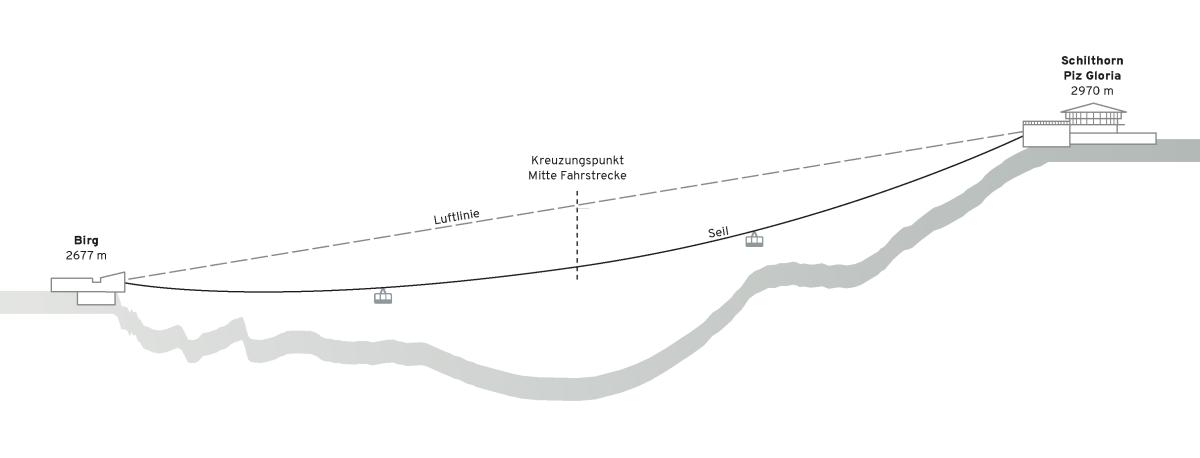Section 3 Birg – Schilthorn

Introduction
The existing single track Birg–Schilthorn cable car will be replaced by a new twin-cabin cable car using the Funifor system. The two track cables are mechanically independent. In normal operations, both tracks are coupled electrically and the cable car is operated as a “traditional” cable car system. In the case of servicing, one track is closed and the second track maintains operations independently with half of the passenger capacity. The cable car serves as access to the popular excursion destination Schilthorn – Piz Gloria and forms the third of three sections. The cable car has two cabins holding 100 persons each, it is set up for operation throughout the year, and can be operated remotely.
Cable car system
Name of the system: 100-FUF Birg–Schilthorn
System number: 71.151
System number: 71.151
-
Two single track cable cars using the Funifor system, each with one cabin and operating on a shuttle basis -
Cabins holding 100 persons each -
Passenger capacity 2 x 400 persons per hour -
Max. speed 7.5 m/s -
Adhesion traction in the valley station (355° loop system) -
Cable tensioner (basic tension towing cable 300 kN) in the valley station Operation
The cable car is designed for the transport of persons inside the cabins. The passenger capacity is 2 x 400 persons per hour in each direction. The cable car has a load measurement system. The system operates both in summer and winter, day and night and can be operated remotely. When conveying goods or for special transports, the car must be manned.
Birg valley station
The valley station will be completely rebuilt. The carrier cables are guided via the cable saddle to the carrier cable anchors with mooring posts and firmly anchored with approx. 3.2 loopings.
The traction cable is directed into the basement by means of pulleys. The forces are diverted into the concrete foundations via a solid steel construction.
The complete main and standby drives are located in the basement.
The traction cable is directed into the basement by means of pulleys. The forces are diverted into the concrete foundations via a solid steel construction.
The complete main and standby drives are located in the basement.
Schilthorn mountain station
The mountain station will be completely rebuilt. The carrier cables are guided via the cable saddle to the carrier cable anchors with mooring posts and firmly anchored with 3.4 loopings.
Cables
Each track consists of two locked-coil carrier cables with a diameter of 64 mm, which are firmly attached at both stations.
The traction cable has a diameter of 26 mm and is made of galvanised strands.
The traction cable has a diameter of 26 mm and is made of galvanised strands.
Track and track assembly
The track comprises a supporting pylon and two carriageways each with two carrier cables with a wide track (4.6 m). Intermediate supports are erected between the stations and the supporting pylons.
The wheels of the intermediate supports are padded with rubber and, where necessary, equipped with pathfinders for the safe alignment of the traction cable.
The wheels of the intermediate supports are padded with rubber and, where necessary, equipped with pathfinders for the safe alignment of the traction cable.

Cabins
Both cabins can accommodate 100 persons each and are designed for remote operation. The cabin is mounted on a 24-wheel drive with a steel plate hanger. The drive is designed without safety brakes.
Rescue
The system is equipped with an integrated evacuation system. This means that the cabins can always be recalled to the stations. This makes any rescue via the cables redundant.
Electrical equipment
In the case of the electrical drive control, a programmable safety control system is used. The striking feature of this is the high technical safety level with numerous safety relevant functions/monitoring systems that can be implemented.










